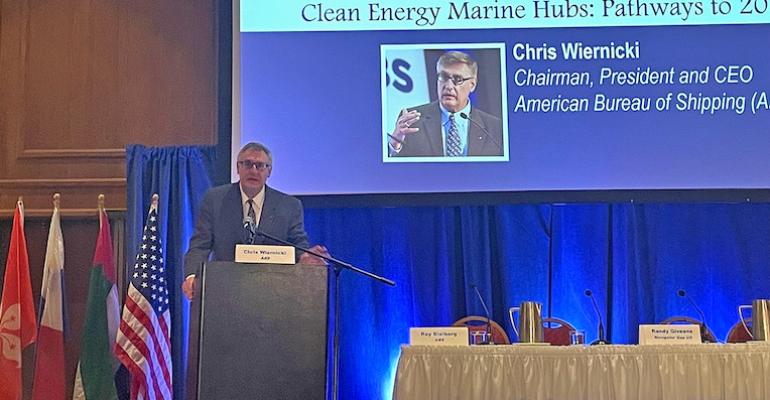With International Maritime Organization (IMO)’s MEPC 79 and MEPC 80 meetings on the horizon, and shipping on the agenda at the upcoming COP27 meeting, decision makers are now trying to begin implementing the green corridors.
In Wiernicki’s keynote at SHIPPINGInsight in Stamford, Connecticut, some new phrases to be added to shipping’s decarbonization lexicon were debuted. He said: “For shipping, the challenge and opportunity lies in two stories: shipping for shipping, which is the decarbonization of our industry, and shipping for the world, highlighting shipping’s pivotal role as an enabler of the global green energy transition. Green shipping corridors and clean energy marine hubs unite these two great shipping stories and offer us a clear pathway to 2050.”
Presaging themes that were repeated in SHIPPINGInsight discussions, the ABS head did caution that, “we need regulatory clarity and consistency. It is not just about the tank-to-wake vs well-to-wake issue. It is also very much about the port to ship issue since port inefficiency will directly impact ship efficiency in terms of CO2 emissions.”
The shipping for the world concept resonated with the audience, with Wiernicki explaining that, “shipping will be the enabler and transport vehicle to bring the next generation of clean fuels to market. An excellent example of this in action is the emerging liquid CO2 carrier market. By connecting producers to consumers, shipping will be the cornerstone on which all related supply chains will be built. In fact, shipping for the world really gets highlighted when you stretch the green corridors and connect them with the clean energy marine hubs. Shipping now becomes part of the solution”
The event provided a powerful backdrop for the release of a detailed ABS report “Green Shipping Corridors -Leveraging Synergies”, which was detailed in an ABS-sponsored session just prior to the main conference. A panel discussion hosted by ABS provided a nuanced view on how corridors might work. In the new ABS publication, they define the corridors as “…as a shipping route between two major port hubs (including intermediary stopovers) on which the technological, economic and regulatory feasibility of the operation of zero emission ships are catalysed through public and private actions.”
The ABS approach reflects a middle ground between the acutely analytical Maersk McKinney Møller Institute/ McKinsey blueprint (released two weeks prior), and a much more incremental approach outlined by panelist David Cummins, of the Blue Sky Coalition. Cummins, who spent more than three decades in various roles with oil giant Shell, implored those scoping out possible corridors to “…just do something…” taking small steps and trying out small initial actions. “You have to start with a vision,” he said, adding that: “You are going to innovate…you are going to learn things as you are taking actions.”
A variant on Cummins’ observation was voiced by another Class leader, DNV CEO, Knut Ørbeck-Nilssen, in the Day 2 keynote speech, who urged industry participants to aim for practical readily implementable actions in developing decarbonization solutions (including the corridors). Taking a famous quote from the philosopher Voltaire, he reminded the audience that: “The perfect is the enemy of the good.”
You can download the ABS report “Green Shipping Corridors - Leveraging Synergies” here
Copyright © 2024. All rights reserved. Seatrade, a trading name of Informa Markets (UK) Limited.
Add Seatrade Maritime News to your Google News feed.  |

